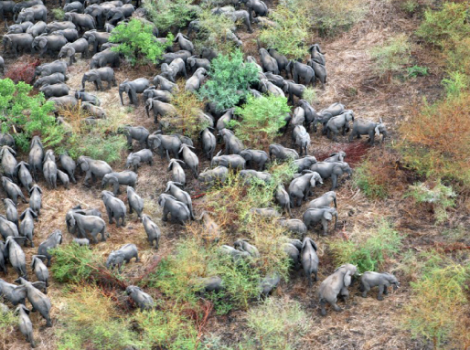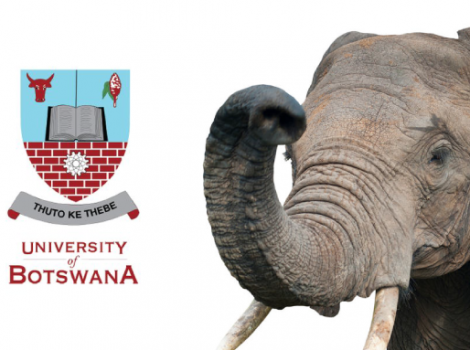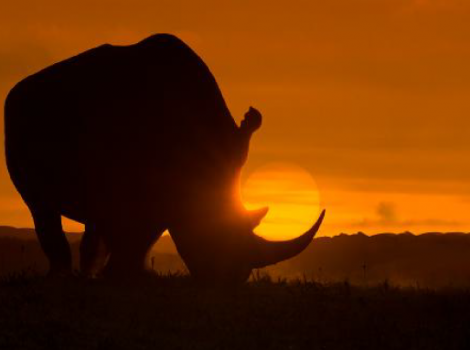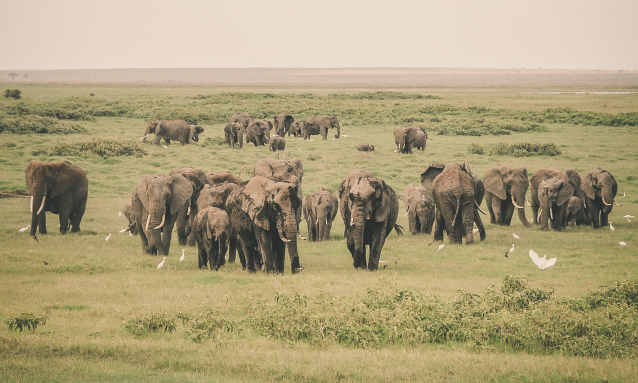
Aerial surveys indicate a greater concentration of elephants in Botswana than anywhere else in Africa. Botswana is home to the largest population of elephants in Africa, an estimated 150 000 depending on the time of year, immigration, emigration, and birth and death rates.
In comparison, the Kruger National Park has just 17 433 elephants, according to the Great Elephant Census 2016.
In Chobe National Park, where you can find the highest concentration of elephants in Botswana, in places along the riverfront in the dry season there can be an estimated five elephants per square kilometre, although opinions vary.
Elephants strolling through the village or even a warthog recumbent outside your tent or strolling importantly around town followed by a line of piglets doesn’t even raise an eyebrow in Kasane.
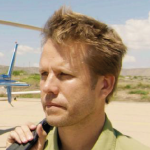 The source of the stats given in the article was Elephants Without Borders (EWB), a charitable organisation founded by Mike Chase (pictured) and Kelly Landen, whose mission is dedicated to ‘Conserving wildlife and natural resources; through innovative research, education, and information sharing with all people, as well as striving to encourage mankind to live in harmony with wildlife and the natural world’.
The source of the stats given in the article was Elephants Without Borders (EWB), a charitable organisation founded by Mike Chase (pictured) and Kelly Landen, whose mission is dedicated to ‘Conserving wildlife and natural resources; through innovative research, education, and information sharing with all people, as well as striving to encourage mankind to live in harmony with wildlife and the natural world’.
To find out more, Ann Gadd, a writer with Country Life (SA) spoke to the EWB’s Programme Manager, Kelly. Kelly is a dedicated conservationist, with a host of skills to her name, including marine captain, photographer, and field guide/naturalist in North and South America, as well as Alaska. Currently, among many other responsibilities, she is an aerial survey observer and orchestrator of the organisation’s projects.
In response to talk of large increases in the elephant population in Chobe, Kelly said;
“Not so. There is said to be an annual increase of five percent under normal conditions in the wild, although in the Chobe area and across Botswana we’re not finding that to be the case. In fact, although in the 80s and 90s the population was increasing, recently we have seen a shift to what appears to be a stabilised population.
We are assuming, then, that this must be because the mortality rate has increased, fewer elephants are being born or that they are moving to other countries. It’s possibly a combination of these three factors. It must also be noted that 29 percent of the carcasses spotted in the Chobe enclave and the Okavango Delta were found close to human habitat. It’s known that there has been conflict in these areas between local communities and the animals.”
Kelly explained that for all the challenge of communities living alongside some of the world’s largest wildlife populations, there is an increasing understanding of the importance of wildlife tourism to improve the quality of life for these rural villages.
“Reconciling the needs of elephants and of people is a mission Elephants Without Borders is committed to.”
While flitting over the plains of Africa might appear to be everyone’s dream, the aerial surveys require hours cooped up in small airplanes, which are noisy and uncomfortable (the temperatures inside can reach 53°C). At times, an hour can pass without a sighting, making the process tedious, and only for the most dedicated of conservationists.
“But it’s an amazing experience to witness and document everything from the air,” says Kelly, “although it can be very trying on one’s perseverance and concentration. But we recognise the importance of these surveys. It’s a huge responsibility that I’m honoured to carry.”
For his part, co-founder Mike Chase explains the surveys;
“The purpose of each census is to motivate and inspire decision makers with information that they previously did not have. The Great Elephant Survey is the largest and most accurate survey of elephants in Africa and is being used to assist in conservation and elephant ecology, and already has had a profound effect on elephant conservation.”
Mike further highlighted that for the moment, in Botswana the elephants’ existence is stable, unlike the tragic decline in areas such as northern Cameroon, Mali, Mozambique and Angola. But it’s not a situation “for which we can show relief, and then forget about. And nor must we ever forget those men and woman dedicated to preserving our wildlife.”
Chobe and Makgadikgadi National Parks, Nxai Pan, Moremi Game Reserve, the Okavango Delta and the surrounding Wildlife Management Areas in Ngamiland, Chobe and Central districts were surveyed, totalling a massive 73 478km², to ascertain the population of elephants in the areas.
It was to be the first independent, aerial, fixed-wing survey of its kind in the area, where 20 percent (as opposed to the previous, government-sponsored 5 percent) of the area would be covered, to ascertain wildlife population. It was no small undertaking, requiring 250 hours of flying time.
The results, when compared to earlier surveys of the Botswana government, showed that 11 of 14 animal species had a population decrease of an average 61 percent (particularly in the Okavango Delta), between 2006 and 2010. Worst affected were wildebeest in the Okavango Delta. However, it wasn’t all doom and gloom, as the survey confirmed that elephant populations across northern Botswana appeared to have stabilised and were possibly increasing.
2011/2013 Survey
Between 2011 and 2013, EWB surveyed an area of roughly 22 560km² over the Chobe District (Chobe National Park, Chobe Forest Reserve, Kasane and surrounding Wildlife Management Areas).
In both instances, the elephant population was found to have stabilised overall, although in certain areas such as Chobe National Park, the numbers appeared to have decreased. This reduction in numbers could be due to the fires and dryness experienced at the time of the survey, meaning that the elephants may have moved to other areas or countries.
The Great Elephant Census 2016
Headed by Elephants Without Borders’ Mike Chase, it involved a whopping 406 days of flying time by 81 aircraft. It has provided the first list of 18 countries and their African elephant populations and data on their increase or decrease. Although some areas had shown an increase or decrease, according to EWB, Botswana’s overall results showed a stabilised population.
Source: FYI from @ http://www.countrylife.co.za/wildlife-2/botswanas-sky-watch
By Ann Gadd

